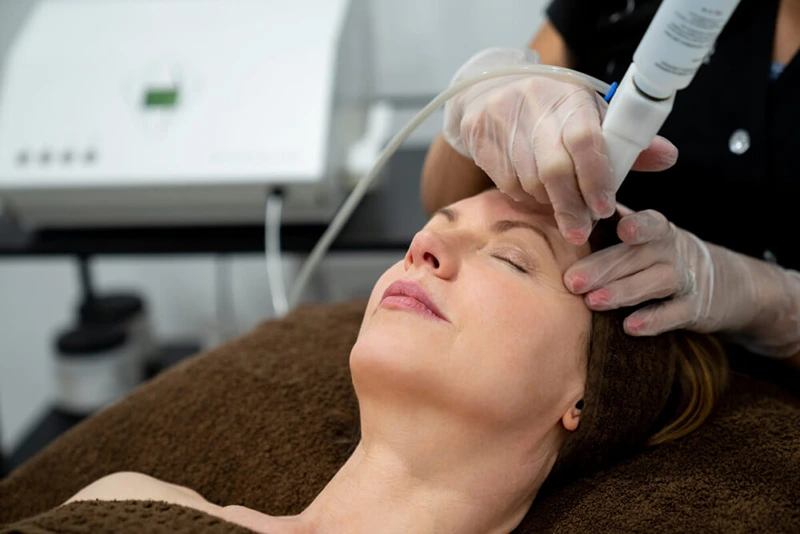Pros And Cons Of Fractional Laser Skin Treatments

Laser technology has revolutionized many aspects of our lives, from information processing tools to genetic engineering and medical applications. Specifically, the evolution of laser therapy has found its way in delivering cutting-edge cosmetic treatments that are widely popular even to celebrities.
So what are the pros and cons of fractional laser skin treatments? These procedures stimulate collagen formation to address skin concerns. These treatments however aren’t for everyone, as they produce side effects that some may not be able to tolerate well.
Rejuvenate and heal your face with the technique proven time and time again to provide maximum regenerative results: microneedling. Call us today to book your microneedling appointment at aNu Aesthetics.
Comparison Of Different Fractional Laser Skin Treatment Techniques
It may be a bit overwhelming to know that there are a lot of laser light therapies available today and this may make it hard for you to choose which one of them that you want your skin to undergo. With that, we’re here to show you a comparison of the different fractional laser skin treatment techniques to give you a better idea of how they work.
1) Ablative Laser Resurfacing
Ablative laser resurfacing works by vaporizing the water content of the outer layer of skin to facilitate its removal, thus stimulating collagen production. This process leads to a more dramatic skin tightening effect and is useful for addressing more extensive skin damage such as deep facial wrinkles. It is considered to be a more aggressive treatment when compared with non-ablative laser resurfacing because the latter can leave the skin intact.
4 to 6 treatment sessions spaced one month apart are needed for the maximal results of the treatments to be achieved and around 2 to 3 weeks of downtime is expected.
Here are the examples of ablative laser techniques available and their specific features.
| CO2 Ablative Lasers | The wavelength of light emitted by a carbon dioxide laser is 10,600 nm, enough to vaporize the water content of the skin cells and also cause thermal damage. Through the destruction of old collagen, new healthy collagen is stimulated to be produced. Two types of CO2 lasers present today are the Ultrapulse, a high-power pulsed CO2 laser, and the AcuPulse, a scanning CO2 laser that uses fractionated light. |
| Er:YAG Ablative Lasers | The wavelength of light emitted by erbium-doped yttrium aluminum garnet (Er:YAG) is 2940 nm. It has less severe side effects than CO2 ablative lasers although it is observably less effective than CO2 ablative lasers when it comes to skin tightening. |
| Combined CO2 Er:YAG | The combined CO2 Er:YAG aims to incorporate the best features of the two; that is, it aims to produce less side effects while still being effective for skin tightening. |
2) Nonablative Non-fractional Laser Resurfacing
Nonablative non-fractional laser resurfacing is a gentler form of light therapy compared to ablative laser resurfacing so its downtime is comparably shorter and the side effects are less drastic. Effects of nonablative lasers are more visible on the surface and lie more on textural improvements and changes in skin complexion.
On average, 4 to 6 treatment sessions are also needed for the effects of these modalities to be seen and it will only take a few days for the skin’s recovery period from this treatment.
Here are the examples of nonablative non-fractional laser resurfacing techniques available and their specific features.
| 1319-nm Pulsed Energy Laser (Sciton Thermascan) | The 1319-nm pulsed energy laser is helpful for wrinkle improvement and is safe for all skin types and colors. It utilizes the large-area pattern generator (LAPG) for even and nonsequential distribution of the laser throughout its path. |
| 1320-nm Nd:YAG Laser (CoolTouch CT3Plus, Alma Harmony XL) | The 1320-nm Nd:YAG laser produces a wavelength of light that can be absorbed by the skin’s water content. It targets the dermis layer of the skin to boost collagen production while keeping the epidermis intact. |
| 1450-nm Diode Laser (Candela Smoothbeam) | The 1450-nm diode laser is capable of reducing acne-related skin concerns through the partial destruction of sebaceous glands leading to decreased sebum production. |
3) Nonablative Fractional Laser Resurfacing
Nonablative fractional laser resurfacing is the latest and most gentle type of the three, incorporating the feature of nonablative lasers to keep the epidermis intact and the feature of fractional lasers that also ensure that the treatment is effective and safe.
An average of 3 to 5 treatment sessions are needed for the effect of nonablative fractional laser to be seen and with a downtime of around 3 to 5 days.
Here are the examples of nonablative fractional resurfacing techniques available and their specific features.
| 1410-nm Laser (Solta Fraxel Re:Fine) | Fraxel lasers enabled the deep penetration depth of light while keeping the epidermis intact through the introduction of the microscopic treatment zones (MTZs) which are columns of light slightly smaller than a hair follicle. |
| 1440 Nd:YAG Laser (Cynosure Affirm and Palomar StarLux) | The 1440 Nd:YAG laser is basically an improvement of the 1410-nm laser with its targeted system that only focuses the light on the desired area to be treated and cooling system for maximal patient comfort. |
| 1540-nm (PalomarStarLux 1540 and Palomar Icon), 1550-nm Erbium Glass Lasers (Solta Fraxel re:store) and the Combination of 1550-nm Erbium Glass and 1927-nm Thulium Fiber Lasers (Solta Fraxel re:store DUAL) | The erbium glass lasers of different wavelengths have both the features of ablative and nonablative lasers, in which the controlled heating of the dermal layer confers less side effects but provides effective treatment for skin concerns on both the epidermis and dermis. |
Benefits Of The Fractional Laser Skin Treatments

Benefits of the fractional laser skin treatments stem from the fact that these treatments stimulate the production of collagen. Indication for treatment using this effective modality include the following:
- To tighten loose and sagging skin;
- To reduce the visibility of stretch marks;
- To reduce the appearance of wrinkles and fine lines;
- To improve the appearance of skin tone by evening it out and fading age spots;
- To minimize any form of scarring such as acne scarring, traumatic scars, and surgical scars through collagen shrinkage;
- To make prominent blood vessels such as spider veins less visible;
- To effectively make pores smaller; and
- To remove unwanted hair such as from the underarms and legs.
Patient Satisfaction With Fractional Laser Skin Treatments
A comparison of the satisfaction of patients with their skin appearance before and after the treatment shows that there’s high patient satisfaction for patients who undergo fractional laser skin treatments. Because of the ability of these treatments to effectively address skin concerns no matter the skin type, the patients reportedly became satisfied with the results no matter how high their expectations are. Increased self-esteem and self-satisfaction are the major factors why these patients are happy with the results of the treatment.
Is Fractional Laser Skin Treatment For You?
Despite the wide applications of fractional laser skin treatment for dermatological diseases, careful patient selection is still a must since fractional laser treatments aren’t for everyone. While you would still need to consult a doctor to know what treatment will work best for the disease entity you’re suffering with, reading below may still give you insights to know if fractional laser treatments aren’t for you or not.
Side Effects Of Fractional Laser Skin Treatment

While features of the different types of fractional laser treatments vary, side effects of the treatment vary as well, also depending on the type of treatment.
1) Ablative Laser
Ablative laser treatments have numerous side effects such as the following:
- Redness, swelling, and itching may occur due to inflammatory responses of the skin triggered by the treatment. Redness may also be brought by the worsening of other disease entities such as rosacea.
- Acne may be exacerbated due to the application of creams and bandages after treatment.
- Infection may be caused by ablative laser treatments especially when you touch the treated area with your hands. The treatments may also trigger the reactivation of the herpes virus to produce cold sores again.
- Pigmentation of the skin may also change because of the treatment. The skin may be lighter or darker and is usually more common on darker skin tones.
- The appearance of scarring, although rare, may be brought by ablative laser resurfacing permanently.
- Ectropion or when the inner surface of the eyelid gets exposed, although also rare, may be brought by ablative laser resurfacing.
2) Non-Ablative Laser
While less severe than the former, non-ablative laser treatments still have side effects which are the following:
- Infection and changes in skin pigmentation may also be brought by non-ablative laser procedures.
- Swelling and redness may also be brought by non-ablative laser, although to a milder extent and at a shorter time than ablative laser.
Who Fractional Laser Skin Treatment Isn’t For
People who can’t undergo laser resurfacing include those who:
- Are prone to sun damage and can’t avoid unprotected sun exposure;
- Have chronic conditions such as an increased risk for irregular pigmentation (e.g., those belonging to Fitzpatrick skin types IV-VI);
- Have a medical history of being highly likely to form hypertrophic scars and keloid scars;
- Have other medical conditions such as scleroderma, vitiligo, lichen planus, and psoriasis; and
- Are undergoing and/or have undergone chemotherapy or radiation therapy;
Professional Cosmetic Services At aNu Aesthetics
Laser skin resurfacing, may it be ablative treatment or nonablative lasers, use light energy to boost collagen production and promote collagen remodeling. It has its pros and cons and works depending on the type of treatment that you are considering.
Make the most out of these laser skin resurfacing techniques with our team of professional aestheticians at aNu Aesthetics headed by Dr. Cristyn Watkins. We are sure to help give you the type of fractional laser technology that is the most effective treatment option for you. Contact us today at (816) 670-4406.
Learn More: Do You Really Need To Wait For 6 Weeks Before You Do Morpheus8 Treatment Again?
Rejuvenate and heal your face with the technique proven time and time again to provide maximum regenerative results: microneedling. Call us today to book your microneedling appointment at aNu Aesthetics.